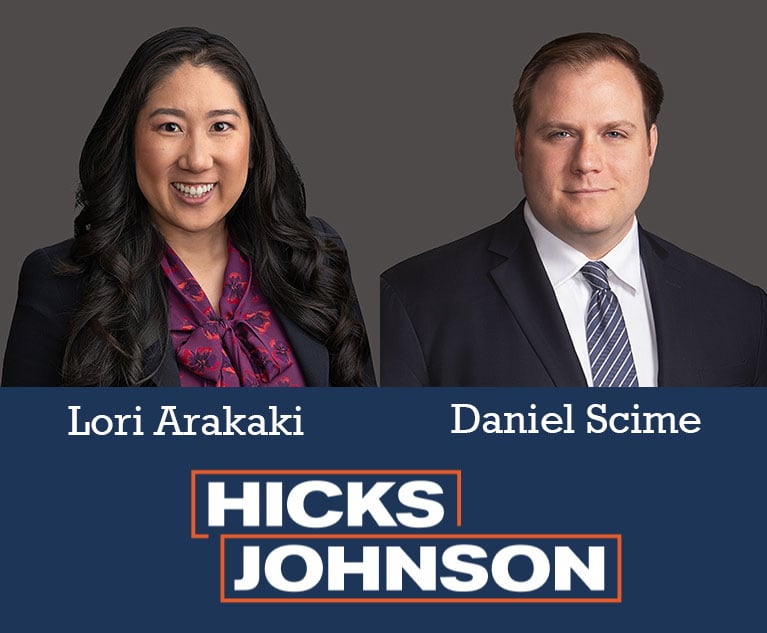12. Build in Time for Creative Thinking On Behalf of Your Client
Clients want you to see around corners, here's how to do it.
April 19, 2021 at 12:41 AM
6 minute read
The original version of this story was published on Lean Adviser
The purpose of the Lean Law Program is to discuss how to practice law the way clients want in that new reality. The aspiration then, is to offer a set of tools and ideas that can be difference-makers. Creativity is vital to this ambition, and here's where we get to make space for it and discuss it.
Intuition and creativity are what Robert Holden calls success intelligence. And when you think about it, isn't that why you became a lawyer?
Let's be realistic, there are plenty of good lawyers out there. This is true in all disciplines of law. The clients know who they are and how to find them. But if you ask about creative lawyers, suddenly we're talking about a rarer breed. And this is what clients want. Debbie Hoffman, GC of Digital Risk LLC put it succinctly. "When we call outside counsel, we know what the law says — we want to know what the nuance is, what are the gray areas. We're not just looking for the basic, black-letter law answer to our question."
This requires a template for a creative component. Our name for this creative component is 'Just in Case,' or JIC. Every component we have seen so far is lean, even minimalistic. Plan the project, create a lean process, go directly to it, and only do just what matters. But this is a legal process not a manufacturing one, and as lawyers we all need that extra layer of vigilance that asks, 'What have we missed?'
Smart manufacturing says buy only what you need and acquire it 'Just In Time' or JIT. This acronym appears on many of the lean manufacturing infographics. But smart lawyering doesn't leave anything to the last moment. Nor does it squeeze the last bit of capacity out of the day. Those practices are not in clients' interests. In doing 'Just What Matters,' it is essential to plan for extra actions, just in case. Where manufacturing has JIT, in legal services we suggest JIC.
Just in Case, or JIC, sits in our Lean Law template as a specific component. It's there to balance the lean-ness. It is the final piece of the execution stage, to address the possibility of missing something material, which creative reflection might expose. Every system on an aircraft has a back-up. It's called redundancy. Likewise, in every good IT structure, there is a back-up or 'fall over' system. 'Redundancy' or 'resilience,' depending if you're in a factory or on a railway, is what makes any structure safe. It also makes the practice of law safer.
What we call a 'JIC' event, others might call a 'case conference' a '360 review' or a 'progress review.' JIC is a pause. It is a specific step in the template where you stop and look around. When we say 'stop and look around,' we do mean it to be taken literally. We all tend to think about the work 24/7. We all have moments of inspiration or terror in the shower and on the train. But this is different. It is a planned event. Whether the team is one lawyer or a group, 'stop' means make a calendar entry and create a 'JIC event' or whatever you'd like to call it. And 'look around' means just that. Take as much time as is necessary and in a structured way, look back, look laterally, and look forward. It is more than just taking stock of everything you've seen. It is a time to imagine the consequences of what you've seen, and also to imagine what you might not have seen at all.
➤ REVIEW RELATED TOOL: Contingency Planning Checklist
What to Bring to a JIC Event
Participants, who often include the client, often ask what to bring to a JIC event and how to prepare. The answer is, just bring imagination and vision. That also answers how to prepare, because ideally the participants will have the facts and issues marinating in their heads beforehand. A JIC event is not the place for a deep dive into documents (although such a task might be a follow up action). Often JIC work calls for just one prompter document, like an issue list, the sort of thing we all see at an early stage, and hopefully regularly updated.
How a JIC Event Works
We've said that 'Just What Matters' is about using our eyes to see what's important, and that the 'Do It Lean' component is about using our hands to get on and do the work. So all that remains is to use our brain. Specifically, this work calls for access to the 'right brain,' which is associated with imagination and creativity. A JIC event is a classic brainstorm. Perspective is variable. It is just as easy to miss something by being too close as it is too remote. The methodology of a JIC event is to unpack the entire project.
Break the Project Open, Pull Each Issue Apart, and Look for Nuances, Gaps and Connections
'Perspective' and its cousin 'knowledge' share a family trait, they tend to be whimsical. That which was once a suspicion can, over time become an assumption, and then it can somehow join the ranks of the known facts. It will remain so until you dismantle the project and someone says 'remind me what's the provenance of this.' So a JIC event will stress test all the 'knowns' and unknowns, and then attempt the even harder task of trying to see round corners.
Most of all, use vision and imagination. Try to see what might have been missed, what could be shored up and what could go wrong. This analysis lends itself to a mind-map or a flowchart. Or the output may be a schedule of action items. And if everything is assured as water-tight then perhaps nothing more is required from the JIC, other than to set a date for the next one.
Is JIC a luxury? Maybe, but if so then it is a vital luxury, regardless of whether it can be billed. So long as it is handled transparently and proportionately, most clients are happy to pay for it. It is, after all, only using an energy budget of won-back time resulting from efficiencies elsewhere. The other components of Lean Law 'create space' for this one.
We will soon turn to monitoring progress and holding progress reviews. In practice it often makes sense to arrange progress reviews and JIC events back-to-back.
NOT FOR REPRINT
© 2025 ALM Global, LLC, All Rights Reserved. Request academic re-use from www.copyright.com. All other uses, submit a request to [email protected]. For more information visit Asset & Logo Licensing.
You Might Like
View All
Former Federal Judge Christopher Conner Joins Saxton & Stump as Attorney and Shareholder
2 minute read
Gibbons Reps Asylum Seekers in $6M Suit Over 2018 ‘Inhumane’ Immigration Policy
3 minute read
Fellows LaBriola LLP is Pleased to Announce that Alisha Goel Has Become Associated with The Firm
1 minute read
Hicks Johnson Promotes Lori Arakaki and Daniel Scime to Firm Partnership
2 minute readTrending Stories
- 1New York-Based Skadden Team Joins White & Case Group in Mexico City for Citigroup Demerger
- 2No Two Wildfires Alike: Lawyers Take Different Legal Strategies in California
- 3Poop-Themed Dog Toy OK as Parody, but Still Tarnished Jack Daniel’s Brand, Court Says
- 4Meet the New President of NY's Association of Trial Court Jurists
- 5Lawyers' Phones Are Ringing: What Should Employers Do If ICE Raids Their Business?
Who Got The Work
J. Brugh Lower of Gibbons has entered an appearance for industrial equipment supplier Devco Corporation in a pending trademark infringement lawsuit. The suit, accusing the defendant of selling knock-off Graco products, was filed Dec. 18 in New Jersey District Court by Rivkin Radler on behalf of Graco Inc. and Graco Minnesota. The case, assigned to U.S. District Judge Zahid N. Quraishi, is 3:24-cv-11294, Graco Inc. et al v. Devco Corporation.
Who Got The Work
Rebecca Maller-Stein and Kent A. Yalowitz of Arnold & Porter Kaye Scholer have entered their appearances for Hanaco Venture Capital and its executives, Lior Prosor and David Frankel, in a pending securities lawsuit. The action, filed on Dec. 24 in New York Southern District Court by Zell, Aron & Co. on behalf of Goldeneye Advisors, accuses the defendants of negligently and fraudulently managing the plaintiff's $1 million investment. The case, assigned to U.S. District Judge Vernon S. Broderick, is 1:24-cv-09918, Goldeneye Advisors, LLC v. Hanaco Venture Capital, Ltd. et al.
Who Got The Work
Attorneys from A&O Shearman has stepped in as defense counsel for Toronto-Dominion Bank and other defendants in a pending securities class action. The suit, filed Dec. 11 in New York Southern District Court by Bleichmar Fonti & Auld, accuses the defendants of concealing the bank's 'pervasive' deficiencies in regards to its compliance with the Bank Secrecy Act and the quality of its anti-money laundering controls. The case, assigned to U.S. District Judge Arun Subramanian, is 1:24-cv-09445, Gonzalez v. The Toronto-Dominion Bank et al.
Who Got The Work
Crown Castle International, a Pennsylvania company providing shared communications infrastructure, has turned to Luke D. Wolf of Gordon Rees Scully Mansukhani to fend off a pending breach-of-contract lawsuit. The court action, filed Nov. 25 in Michigan Eastern District Court by Hooper Hathaway PC on behalf of The Town Residences LLC, accuses Crown Castle of failing to transfer approximately $30,000 in utility payments from T-Mobile in breach of a roof-top lease and assignment agreement. The case, assigned to U.S. District Judge Susan K. Declercq, is 2:24-cv-13131, The Town Residences LLC v. T-Mobile US, Inc. et al.
Who Got The Work
Wilfred P. Coronato and Daniel M. Schwartz of McCarter & English have stepped in as defense counsel to Electrolux Home Products Inc. in a pending product liability lawsuit. The court action, filed Nov. 26 in New York Eastern District Court by Poulos Lopiccolo PC and Nagel Rice LLP on behalf of David Stern, alleges that the defendant's refrigerators’ drawers and shelving repeatedly break and fall apart within months after purchase. The case, assigned to U.S. District Judge Joan M. Azrack, is 2:24-cv-08204, Stern v. Electrolux Home Products, Inc.
Featured Firms
Law Offices of Gary Martin Hays & Associates, P.C.
(470) 294-1674
Law Offices of Mark E. Salomone
(857) 444-6468
Smith & Hassler
(713) 739-1250








